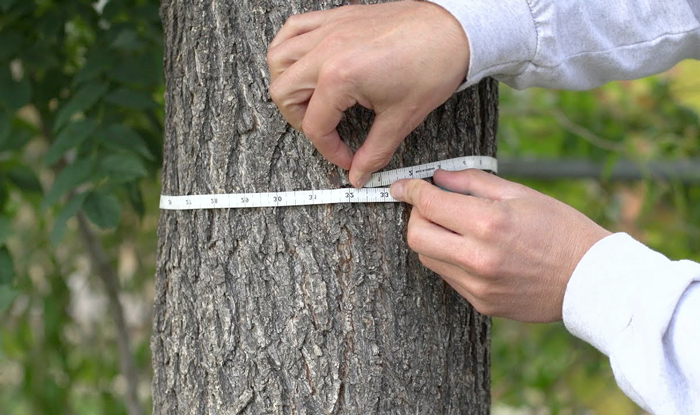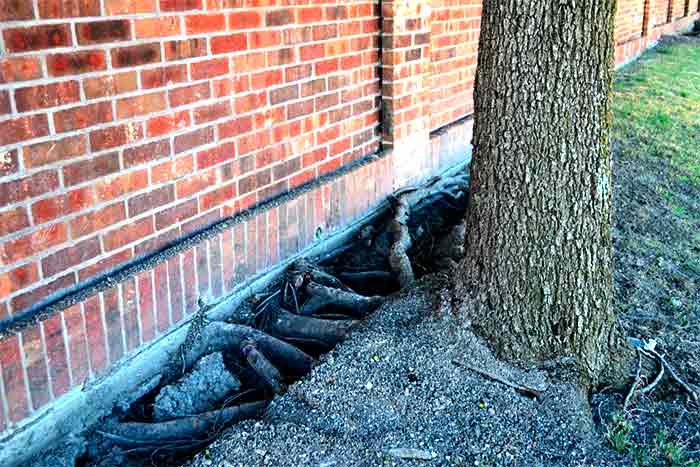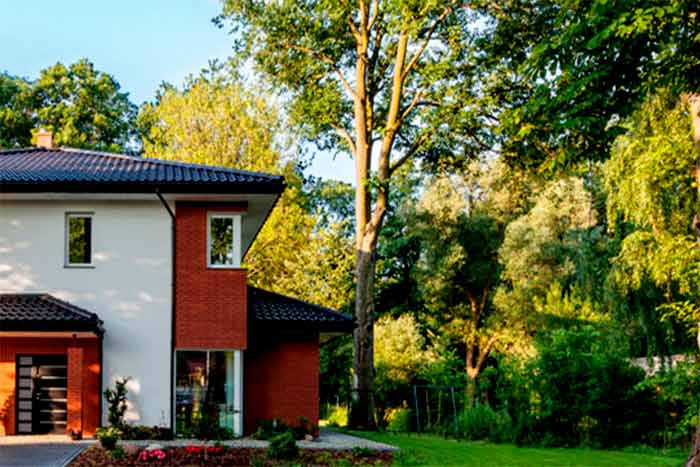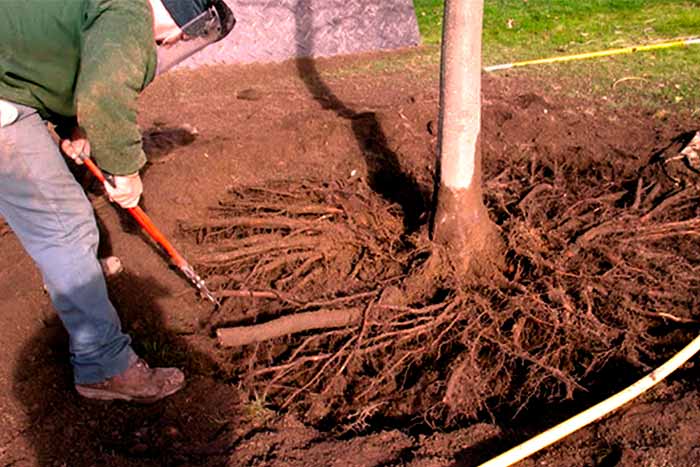Trees with highly invasive root systems, which often extend horizontally, frequently lead to foundation damage. This issue is particularly prevalent with trees that require a lot of water. Hence, it’s recommended to plant these types of trees at a considerable distance from a house’s foundation.
Here is what you should know about how tree roots can damage your foundation, the type of trees1 that you should never plant close to your home, and what you can do to keep your foundation damage-free.
What we cover
ToggleCalculate ideal distance to plant trees

There is a formula so you can calculate the safe distance a tree should be from your home.
Take the diameter of your tree and multiply it by 5 for the absolute minimum distance.
Example: 2 feet (trunk diameter) x 5 = 10 feet min distance
The 5 rule is the minimum with an ideal safe distance being 10 times the trunk diameter.
Which trees have the most invasive roots?
The following trees are examples of varieties that have very invasive roots;
- Silver maples
- Willows
- Elms
- Honey locusts
- Aspens
- Japanese knotweeds
- Sycamores
- Hybrid poplars
- Southern magnolias
Planting any of these trees near your home’s foundation will be a disaster since their root systems tend to grow fast and laterally. And while they won’t penetrate your home’s foundation, they will cause a pressure imbalance in the soil that is adjacent to your home’s foundation. This will lead to shifts in your foundation that will then cause extensive damage.

How do I protect my foundations from tree roots?
Prevention
The first thing that you can do to protect your foundation is to avoid planting trees with aggressive root systems in your home. Sticking with whose roots grow vertically, and which have a slow growth rate, will reduce the risk of damage.
If you are planning on planting trees with aggressive root systems, then the best thing you can do for your home is to plant them far away from your home.
Planting them at a distance that is over 25 feet will make it harder for their roots to reach your home’s foundation. The distance will offer a reliable buffer against root invasion, making things safer for your foundation.
Mitigation
If tree roots are already invading your foundation and causing damage, then you can prevent further damage by simply cutting off the invasive roots. However, while this is an effective way of preventing foundational cracks and other signs of foundational damage, you should be careful when cutting a tree’s roots.
Some trees completely die off when their roots are cut. Therefore, it is usually advisable that you do so under the guidance or with the help of an arborist.
Building root barriers is also an effective way of preventing damage. These barriers are effective at redirecting root systems downwards and hence stopping them from growing under the home’s foundation. They are also useful in cases where a tree’s roots have been cut. In such a case, installing a root barrier will keep the roots from regrowing in the direction of your home’s foundation.
Root pruning
Removing the offending root is also an effective method of protecting your home’s foundation. It is in fact a cost-effective and convenient option in cases where the tree doesn’t have enough value to justify spending money on curbing the spread of its roots. While it is possible to remove the tree on your own, if it is too large, hiring a tree surgeon is always advisable. Having an expert handle the removal process will be safer, and in some cases, it can end up saving your money.

How close can you plant a tree to your home?
Trees that don’t have extremely aggressive root systems can be planted between 10 to 15 feet away from a home. However, a distance of over 25 feet is a safer bet for trees with invasive root systems. Closer than 10 feet is too close for any large tree.
In addition to a tree’s root system, one should also take into account the height of the tree, how thick its branches grow, and the overall diameter of its crown when it grows to maturity. This is so because even for a tree that does not pose a risk to the integrity of a home’s foundation, it can still be detrimental to a home’s shingles if its branches grow wide enough to overhang the roof.
For such trees, they can also pose an injury risk if their bulky branches fall on the home. Therefore, even if such a tree does not have invasive roots, it is advisable that you plant it further away from the home.
Another way to avoid issues is to select a tree with roots that are less invasive2. This will ensure your foundations are never at risk.






Should I remove a tree that is close to my home?
No, just because a tree is close to your home does not mean that you should remove it. This is because some trees do not have highly invasive and aggressive root systems. They may also have slow-growing roots that grow vertically instead of laterally. Good examples are hickory trees, walnut trees, and conifers.
Such trees shouldn’t be removed just because they are close to your home. They typically do not pose any danger to your home’s foundation, and their proximity can, in some cases, be beneficial. This is because having a tree near your home can make it easier for your air conditioning system to regulate your home’s temperature. It can also provide shade to your loved ones, support the existing ecosystem, boost your home’s aesthetic appeal, and provide much-needed privacy against neighbors with prying eyes. In some cases, having a tree close to a home can boost the home’s value.
However, you should remove a tree close to your home if it damages your home’s foundation. As a result, if you notice any common signs of a compromised foundation, like large cracks, it may be time to remove the tree.
Just remove overhanging branches instead
Removing a tree near your home may also be necessary if it has large overhanging branches damaging your shingles. Removing branches may also be necessary if the branches create a physical injury or property damage. However, in such a case, it is always advisable to explore the effectiveness and convenience of simply trimming the branches before making as drastic a step as completely removing them. This is so especially if the tree has intrinsic value.
If the tree that is close to your house is dead or dying, removing it is advisable. This is because a dead tree carries a higher risk of falling on your home and damaging it. It also has little to no aesthetic appeal. This also applies to trees that are pest magnets. Removing such trees may be more convenient when compared to the headaches of pest control and mitigating pest damage.
How can you tell if a tree is damaging home foundations?

You can tell if a tree is damaging your home’s foundation if there are obvious signs of foundational damage3, especially on the side where the tree is located. These signs include vertical cracks on the walls near the tree, visibly uneven door and window frames, foundation floor cracks, and shattered or cracked windows especially when there isn’t any other evidence of a reason for such cracks.
Since there are different causes of foundational damage, the next step is to confirm that the suspected tree is actually the cause of these symptoms. To do so, all you have to do is to dig one or two feet deep, next to the home’s foundation.
If you come across tree roots that have invaded the home’s foundation, or which are growing dangerously close to it, then they are the likely source of your problems. If they are, you should consider cutting them, building root barriers, or simply removing the offending tree. You may thereafter have to repair the foundation if the damage done is too extensive.
Can you trim tree roots?
Yes, you can trim tree roots safely without killing the tree.
To do so safely, you will need first to measure the tree’s diameter in inches and then multiply the diameter by either 5 or 8. The resulting number will be the safest distance away from the tree from which you can do the cutting without seriously harming the tree.
Given how important trimming distance is, it is always a good idea to start by marking this distance with colored chalk or spray paint. Thereafter, proceed to use a spade to clear the topsoil from the cutting area and then cut the roots with a root saw. If the roots you are cutting are thin, you can cut them with either a sharp spade, pruning shears, or loppers. Following these tips should be enough to keep offending roots away from your foundation without seriously injuring your tree.
It is important to note that you can still cut closer than the recommended diameter and whether or not the tree will survive will depend on the type of tree and how far along it is in its development. However. as a general rule, it is always prudent to remember that the closer you get to the tree, the higher the chances of seriously injuring it. Because of this, it is usually recommended that you leave root trimming to experts or at least consult with one before starting the root trimming process.

Who trims tree roots?
An arborist, or a tree surgeon, is a person who typically trims tree roots. However, it is possible to safely trim your tree’s roots if you follow the appropriate root-trimming guidelines.
- Hubert Miles, (2023) 27 Tree Species That Are Bad For Foundations. <https://homeinspectioninsider.com/tree-species-that-are-bad-for-foundations/> Accessed: 29-02-2024.
- Inspection Support Network, (2023) How to Pick the Right Trees to Avoid Damage to Your Foundation. <https://www.inspectionsupport.com/how-to-pick-the-right-trees-to-avoid-damage-to-your-foundation/> Accessed: 29-02-2024.
- Hubert Miles, (2024) Tree Root Foundation Damage. <https://homeinspectioninsider.com/tree-root-foundation-damage/> Accessed: 29-02-2024.



